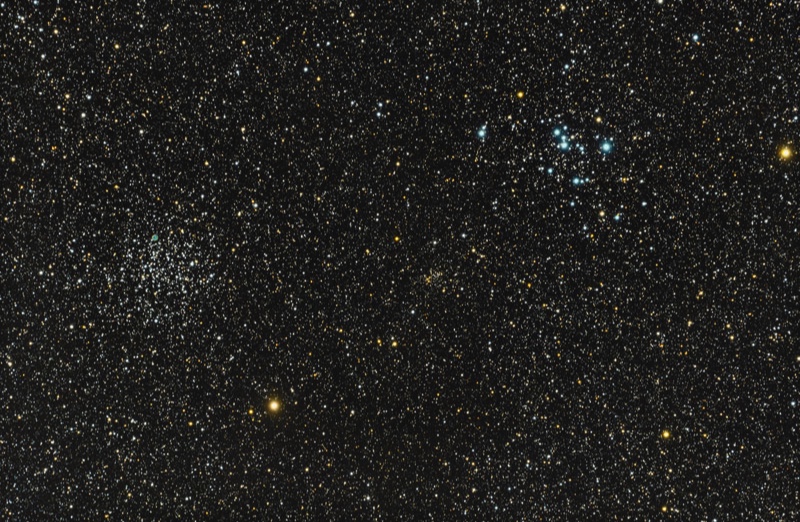M46
Alternate: NGC 2237
Puppis
RA 7h 41.8 m
Dec -14º 49′
Magnitude 6.1
M47
Alternate: NGC 2422
Puppis
RA 7h 36.6 m
Dec -14º 30′ 00′
Magnitude 4.2
M46 and M47 open clusters in Puppis offer vastly different styles of clusters in the binocular view. M46 is about a degree east of M47 in the sky, so the two fit well in a binocular or wide-angle telescope field. This pair of clusters sets before 2:00am this time of year.
Details of M46 can be seen in a previous blog post. M46 is classified as of Trumpler type II,2,r.
M47 was discovered by Hodiernabefore 1654 and independently discovered by Charles Messier on February 19, 1771. It was later independently discovered again, under the nomenclature NGC 2422.
M47 was considered a lost Messier Object. There is actually no cluster in the position indicated by Messier. Messier located the open cluster in terms of right ascension and declination with respect to the star 2 Puppis. However,further examination determined M47 and NGC2422 one and the same, The discovery that M47 and NGC2422 were the same cluster only came in 1959 with a realization by Canadian astronomer T. F. Morris.
M47 is at a distance of about 1,600 light-years from Earth with an estimated age of about 78 million years.There are about 50 stars in this cluster,the brightest one being of magnitude +5.7. As with many open clusters, M47’s Trumpler type ranges from II,3,m to I,3,m and III,2,m. M46 is much older and much further away than M47.
M47 is one of the least densely populated open clusters known. The cluster contains many luminous blue stars and a few older red giants. The brightest stars in M47 have a visual magnitude of 5.7. The single brightest star in the cluster is of the spectral type B2. The cluster also contains two K-type orange giants, each about 200 times more luminous than the Sun.
Like M46, M47 holds an additional treasure within its cluster. The double star at the center of M47 is Struve 1121, with components of magnitude 7.4 and 7.9. Struve 1121 can be cleanly split with a 20×80 or 25×100 binocular or better yet a 102 mm refractor. M46 is a very faint fuzzy spot in a 10×50, with M47 appearing as a much brighter star cluster.
